 |
Integrated Pest Management Control Tactics

The Integrated Pest Management Strategy
The management of insect pests rarely relies on a single control practice; usually a variety of tactics are integrated to maintain pests at acceptable levels. The goal of integrated pest management is not to eliminate all pests; some pests are tolerable and essential so that their natural enemies remain in the crop. Rather, the aim is to reduce pest populations to less than damaging numbers. The control tactics used in integrated pest management include pest resistant or tolerant plants, and cultural, physical, mechanical, biological, and chemical control. Applying multiple control tactics minimizes the chance that insects will adapt to any one tactic. The definition for integrated pest management most relevant to this guide comes from Flint and van den Bosch (1981): "An ecologically based pest control strategy that relies heavily on natural mortality factors and seeks out control tactics that disrupt these factors as little as possible."

Ecological basis
Integrated pest management requires an understanding of the ecology of the cropping system, including that of the pests, their natural enemies, and the surrounding environment. As discussed previously, knowledge about the ecological interrelationships between insects and their environment is critical to effective pest management. This guide emphasizes interrelationships between pest species and their natural enemies.

Economic threshold and sampling
The decision to use an insecticide, or take some other action, against an insect infestation requires an understanding of the level of damage or insect infestation a crop can tolerate without an unacceptable economic loss. The level of infestation or damage at which some action must be taken to prevent an economic loss is referred to as the "economic or action threshold." Action thresholds are available for many vegetable crops. Ideally, these thresholds adjust for changes in market prices, stage of crop growth, cost of pesticides, etc., but in reality most are based on fixed infestation or damage levels.
To estimate the severity of pest infestations, the crop or garden must be sampled. Sampling may entail examining plants and recording the number of pests or amount of damage observed, or traps may be used to capture the pest species to estimate pest abundance. Sampling is conducted at regular intervals throughout the season or during critical stages of crop growth. These sampling techniques, used either alone or in combination, estimate how close the infestation or damage level is to the economic threshold.

Integrated Pest Management Control Tactics

Pest-Resistant Crops
One of the mainstays of integrated pest management is the use of crop varieties that are resistant or tolerant to insect pests and diseases. A resistant variety may be less preferred by the insect pest, adversely affect its normal development and survival, or the plant may tolerate the damage without an economic loss in yield or quality. Disease-resistant vegetables are widely used, whereas insect-resistant varieties are less common but nonetheless important. Examples include varieties of wheat which have tough stems that prevent development of the Hessian fly and cucurbits (squash, cucumbers, melons) that have lower concentrations of feeding stimulants (cucurbitacins) for cucumber beetles. Commercial corn lines with increased concentration of a chemical called DIMBOA display resistance to European corn borer, a major pest throughout the world. In the case of cabbage, the only reliable method of controlling onion thrips is through the use of resistant varieties.
Advantages of this tactic include ease of use, compatibility with other integrated pest management tactics, low cost, and cumulative impact on the pest (each subsequent generation of the pest is further reduced) with minimal environmental impact. The development of resistant or pest-tolerant plant varieties, however, may require considerable time and money, and resistance is not necessarily permanent. Just as insect populations have developed resistance to insecticides, populations of insects have developed that are now able to damage plant varieties that were previously resistant.

Cultural Control
There are many agricultural practices that make the environment less favorable to insect pests. Examples include cultivation of alternate hosts (e.g., weeds), crop rotation, selection of planting sites, trap crops, and adjusting the timing of planting or harvest. Crop rotation, for example, is highly recommended for management of Colorado potato beetle. The beetles overwinter in or near potato fields and they require potato or related plants for food when they emerge in the spring. With cool temperatures and no suitable food, the beetles will only crawl and be unable to fly. Planting potatoes well away from the previous year's crop prevents access to needed food and the beetles will starve. The severity and incidence of many plant diseases can also be minimized by crop rotation, and selection of the planting site may affect the severity of insect infestations.
Trap crops are planted to attract and hold pest insects where they can be managed more efficiently and prevent or reduce their movement onto valuable crops. Early planted potatoes can act as a trap crop for Colorado potato beetles emerging in the spring. Since the early potatoes are the only food source available, the beetles will congregate on these plants where they can more easily be controlled. Adjusting the timing of planting or harvest is another cultural control technique. The earlier planted processing tomatoes grown in the western United States are far less likely to be infested by the tomato fruitworm than those planted later in the season. It is also important to use pest-free transplants. Some vegetable crop transplants can be infested with insect pests, and growers using these transplants are put at a considerable disadvantage.

Physical and Mechanical Control
The use of physical barriers such as row covers or trenches prevents insects from reaching the crop. Row covers can help prevent early-season damage to cucurbits by cucumber beetles, and plastic-lined trenches are effective in trapping large numbers of dispersing Colorado potato beetles in the spring and fall. Cold storage is also considered a physical control and, although it does not necessarily kill the insect pests, it at least stops their development and further feeding on the stored crop. Other methods include hand picking of pests, sticky boards or tapes for control of flying insects in greenhouses and various trapping techniques.

Chemical Control
If all other integrated pest management tactics are unable to keep an insect pest population below an economic threshold, then use of an insecticide to control the pest and prevent economic loss is justified. In most cropping systems, insecticides are still the principal means of controlling pests once the economic threshold has been reached. They can be relatively cheap and are easy to apply, fast-acting, and in most instances can be relied on to control the pest(s). Because insecticides can be formulated as liquids, powders, aerosols, dusts, granules, baits, and slow-release forms, they are very versatile.
Insecticides are classified in several ways, and it is important to be familiar with these classifications so that the choice of an insecticide is based on more than simply how well it controls the pest. When classified by method of application (site of encounter by insect), insecticides are referred to as stomach poisons (those that must be ingested), contact poisons, or fumigants. The most precise method of classifying insecticides is by their active ingredient (toxicant). According to this method the major classes of insecticides are the organophosphates, chlorinated hydrocarbons, carbamates, and pyrethroids. Others in this classification system include the biologicals (or microbials), botanicals, oils, and fumigants. Insecticides may be divided into two broad categories: (a) conventional or chemical and (b) biorational. In this guide we define conventional or chemical insecticides as those having a broad spectrum of activity and being more detrimental to natural enemies. In contrast, insecticides that are more selective because they are most effective against insects with certain feeding habits, at certain life stages, or within certain taxonomic groups, are referred to as "biorational" pesticides. These are also known as "least toxic" pesticides.
Because the biorationals are generally less toxic and more selective, they are generally less harmful to natural enemies and the environment. Biorational insecticides include the microbial-based insecticides such as the Bacillus thuringiensis products, chemicals such as pheromones that modify insect behavior, insect growth regulators, and insecticidal soaps. The majority of insecticides fall into the chemical category because they are typically more effective and can usually be used to control several pests. This provides the economic justification needed for the research and development of such products. In contrast, the more specialized market of the biorationals makes their long-term economic return less favorable.
Despite the advantages of conventional insecticides, the problems associated with their use have been well documented. These include the resurgence of pest populations after decimation of the natural enemies, development of insecticide-resistant populations, and negative impacts on nontarget organisms within and outside the crop system. One of the more serious problems is the development of resistance. Many insect pest species now possess resistance to some or several types of insecticides, and few chemical control options exist for these pests.
If all other integrated pest management tactics are unable to keep an insect pest population below an economic threshold, then use of an insecticide to control the pest and prevent economic loss is justified. In most cropping systems, insecticides are still the principal means of controlling pests once the economic threshold has been reached. They can be relatively cheap and are easy to apply, fast-acting, and in most instances can be relied on to control the pest(s). Because insecticides can be formulated as liquids, powders, aerosols, dusts, granules, baits, and slow-release forms, they are very versatile.
To compare pesticide use patterns, the dose, formulation or percent active ingredient of the product, and the frequency of application must also be considered and are used to calculate the EIQ Field Use Rating. Pesticides with a lower EIQ Field Use Rating have a lower environmental impact. The EIQ concept and techniques are evolving, but this, or a smilar rating, will provide information for appropriate pest management decisions in the future.
Natural enemies are generally more adversely affected by chemical insecticides than the target pest. Because predators and parasitoids must search for their prey, they generally are very mobile and spend a considerable amount of time moving across plant tissue. This increases the likelihood that they will contact the insecticide. When an insecticide is applied, ideally only the target pest(s) should be affected. The goal is to maximize pest mortality while minimizing harm to natural enemies.
The following factors, some of which are used when determining the EIQ, influence the impact of insecticide applications on natural enemies:
- Spectrum of activity. Insecticides toxic to most insects (broad-spectrum) will more adversely affect natural enemies than materials that are narrow-spectrum or selective for specific insect species or life stages. Most insecticides in use today have a broad spectrum of activity.
- Residual (half-life) activity of insecticide. Insecticides that remain toxic to pests for a long time and remain on the treated surface will have a similar effect on natural enemies.
- Coverage and formulation of insecticide. Full coverage sprays will generally have a greater impact on natural enemies than directed sprays, systemics, or bait formulations. Spot or edge treatments directed at localized pest infestations or to a specific plant surface most often occupied by the pest will be less detrimental than those applied to the entire field or plant.
- Dosage and frequency of application. Higher rates and repeated applications will have a more detrimental impact on natural enemies.
- Timing of application. Applying insecticides when natural enemies are not abundant or are less susceptible, such as when immatures are encased in host eggs, can be helpful.
- Susceptibility of natural enemy to insecticide. Some natural enemies are inherently more resistant to insecticides than others, and some populations of natural enemies have been selected either naturally or through the efforts of researchers to possess higher levels of resistance. For example, strains of predaceous mites, rove beetles, lacewings, and species of parasitoids have been selected for increased levels of resistance to insecticides, thereby increasing the likelihood that some will survive insecticide treatments directed at pests. Some of these pesticide-tolerant strains are commercially available. Applications of some fungicides directed at controlling plant diseases can also reduce the incidence of fungal diseases of insects. In general, little can be done about this incompatibility except to use the fungicide only as needed.
In addition to killing natural enemies directly, insecticides may also have sublethal effects on insect behavior, reproductive capabilities, egg hatch, rate of development, feeding rate, and life span. Fungicides and herbicides may also have lethal and sublethal effects on natural enemies.

Taken from:
Hoffmann, M.P. and Frodsham, A.C. (1993) Natural Enemies of Vegetable Insect Pests. Cooperative Extension, Cornell University, Ithaca, NY. 63 pp.

|
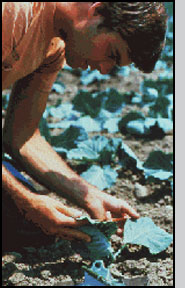
|
Scouting for pests is a very important part of the IPM strategy
Photo: J.Ogrodnick |
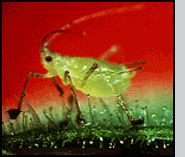
|
Pest-resistant crops include potatoes bred to express hairy, sticky leaves that can trap and kill aphids.
Photo:
W.Tingey |
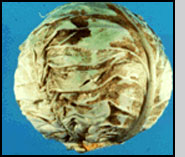
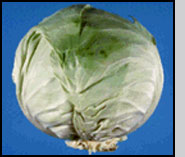
|
Center and Borrom (respectively): Susceptible cabbage attacked by onion thrips, and a thrips resistant cabbage grown in the same field.
Photo:
J.Ogrodnick |
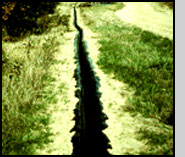
|
Trenches can capture large numbers of dispersing Colorado potato beetles in spring and fall.
Photo:
D.Moyer |
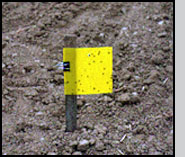
|
A yellow sticky card being used to
monitor flea beetle populations.
Photos:
M.Hoffmann |
|
